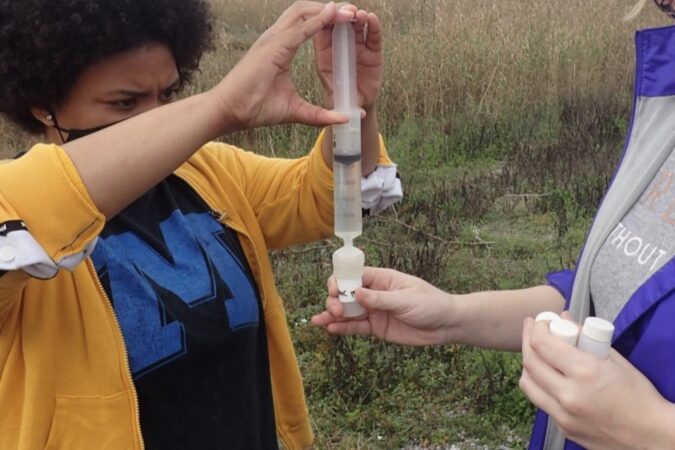
Testing Indicates Environmental Issues Along Waterfront
by Jeremy Morrison, Inweekly
After testing last year revealed the presence of human waste in the waters along downtown Pensacola’s Bruce Beach, city officials expanded testing to find out about issues along a proposed paddling trail. The results are in, and not particularly encouraging.
“I’m not gonna butter it up for you; I’ll just go ahead and lay it out for you,” said Barbara Albrecht.
Albrecht is co-author of the University of West Florida’s Center for Environmental Diagnostics and Bioremediation, along with Dr. Jane Caffery, of the Pensacola Bay Paddling Trail Bacterial Study, which was delivered to the city in late September. In essence, the study confirmed significant levels of Enterococcusi, indicative of animal waste, potentially human waste from wastewater infiltration, at various testing points along the paddling trail, which runs from Sanders Beach along the municipal waterfront of Pensacola Bay and up into Bayou Texar to Carpenters Creek.
Pensacola City Councilwoman Ann Hill initiated this testing along the paddling trail following the concerns raised about issues at Bruce Beach, where the city is investing millions of dollars on a public improvement project designed to draw people to the downtown waterfront.
“I am grateful to Barbara Albrecht and Jane Caffrey for proving what we’ve all suspected for decades,” Hill said in an email. “Namely, that our bay water quality is concerning, particularly after a heavy rain.”
According to this new report, Enterococcus levels spiked after rain events, indicating the issue stems from stormwater and groundwater making its way into the bay due to rain.
“Enterococcus levels at the sampling sites were higher following rain events than during dry periods, with the highest values following rain events greater than 1 inch,” the report states.
A total of 13 sites along the paddling trail were tested for Enterococcus from November 2021 to April 2022. During the testing period, five sites, in particular, showed consistently high levels of E. coli — these sites were Sanders Beach stormwater outfall at I Street; Joe Patti’s stormwater outfall at A Street; Spring Street outfall; Bartram Park; and Upper Bayou Texar at the 12th Avenue bridge.
Conversely, other testing sites yielded more promising results. For example, low levels of Enterococcus were detected in the waters off Maritime Park — likely due to dilution, as the site is further out in the bay — and Bayview Park in Bayou Texar, which Albrecht attributed to stormwater filtration efforts in that area.
These findings align with the earlier testing associated with Bruce Beach, which also indicated that the issue stemmed from polluted stormwater draining into the waterways. The city is currently working with the Emerald Coast Utilities Authority to determine the source of any wastewater infiltration into the stormwater system that is attributing to contamination issues at Bruce Beach; thus far, officials have not determined the source of the contamination.
“The fact that the worst bacterial contamination is closest to our stormwater drains and our oldest sewer pipes confirms that we are on the right track in working with ECUA to locate where the leakage is coming from,” Hill said. “With continued collaboration with our environmental experts, I am hopeful we can one day return our bays, creeks and bayous to good health so we can fully enjoy our amazing public waterfront.”
Such work represents a long-term mission. In fact, ECUA has been under a consent order from the Florida Department of Environmental Protection since 2012, which requires them to inspect and repair the system’s aging infrastructure so that wastewater does not seep out of the lines. While this work is ongoing — with repairs accomplished by lining ancient pipes in place instead of replacing the lines — it is slow and expensive.
Albrecht points to earlier studies that raised the same concerns as this new paddling trail study and laments the pace and seeming lack of urgency. She contends that ECUA should be more proactive in pursuing the directives of the DEP consent order and more communicative with the public.
“That should be out there every month—this is the state of what we have been able to line, and this is where we’re going next,” Albrecht said.
Environmental concerns about the city’s waterfront are nothing new. This new paddling report further verifies the already acknowledged issue. Albrecht wonders if it will actually change anything. Will it spur a speedier and better-funded restoration of the wastewater infrastructure? Will it impact further development in areas that might be unsustainable or environmentally negligible?
“D.C. Reeves claims he’s data-driven,” Albrecht said, referring to Pensacola’s incoming mayor. “Well, that report is packed with data; let’s see what he does with it.”



